Carrier Oils
Before essential oils can be used in aromatherapy they must be diluted in a 'carrier', since they are too powerful to use neat. Whilst there are other carriers such as creams that can be used to dilute essential oils in aromatherapy, carrier oils are the most commonly used medium due to their versatility.
Carrier oils provide the necessary lubrication to allow the hands to move freely over the skin and not 'drag' whilst massaging, whilst at the same time carrying the essential oils into the body. They must be light and non-sticky for this penetration to take place effectively, and preferably have very little odour.

Prunus amygdalus, Prunus dulcis
Family: Rosaceae
Part Used: nuts
Base oil: can be used as a base oil, 100 percent
Sweet almond is native to Asia and the Mediterranean region, and is found in dry soils. The medium-sized tree grows to a height of about 35 feet and has pinkish-white flowers. There are approximately fifty species of the wild almond trees, but only a few varieties produce a sweet kernel.
Contains: glucosides, minerals, vitamins. Rich in protein
Practical Uses: Helps relieve itching, soreness, dryness and inflammation. Good for all skin types. Sun-tanning oil. The carrier/base oil is used to dilute essential oils in aromatherapy for massage oils and other formulations.
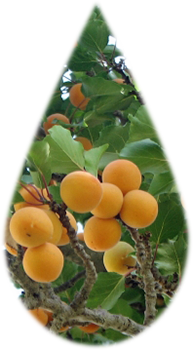 Armeniaca vulgaris, Prunus armeniaca
Armeniaca vulgaris, Prunus armeniaca
Family: Rosaceae
Part Used: kernels
Base oil: can be used as a base, 100 percent
Apricot is native to Asia. The tree grows to a height of about 35 feet, has white to pink flowers and orange-yellow fruit.
Contains: minerals and vitamins
Practical Uses: all skins, especially prematurely aged, sensitive, inflamed and dry. The carrier/base oil is used to dilute essential oils in aromatherapy for massage oils and other formulations.
 Persea americana, Persea gratissima
Persea americana, Persea gratissima
Family: Lauraceae
Parts Used: flesh of fruit
Base oil: use as an addition to a base, 10 percent dilution
Avocado is an evergreen tree native to the Americas. The tree grows to a height of about 30 - 60 feet, has dark-green oval leathery leaves and greenish-yellow flowers that develop into yellow, green, red, or purple, or black fruit. The pulp is soft and buttery with a large kernel inside. Avocado grows in many tropical regions.
Contains: vitamins A and D, protein, lecithin, fatty acids
Practical Uses: all skins, especially dry and dehydrated; eczema. The carrier/base oil is used to dilute essential oils in aromatherapy for massge oils and other formulations. For massage oils, it is best to mix 10 - 20 percent of avacado oil with another carrier before adding the essential oils.
 Borago officinalis
Borago officinalis
Family: Boraginaceae
Part Used: seeds
Base oil: for massage oils, it is best to mix 20 percent of borage oil with a lighter carrier oil before adding the essential oils.
Borage is native to the Mediterranean region. The plant grows to a height of about 2 – 4 feet, has large pointed oval leaves, and star-shaped, sky-blue or purple flowers. The scent of the plant is similar to a cucumber.
Contains: The oil contains one of the highest amounts of gamma-linoleic acid (GLA), which is said to help slow down the skin’s aging process. It has also been reported to be helpful in reversing damage from multiple sclerosis. A lack of GLA in the body prevents nerve cell membranes from functioning properly. GLA is needed for conduction of electrical impulses throughout the nervous system
 Daucus carota
Daucus carota
Family: Apiaceae
Part used: roots
Base oil: use a 10 percent dilution. Do not use undiluted on skin
Carrot oil is an essential oil in its own right, but often used in base oils. Carrots are native to Afghanistan and the Mediterranean region. The plant grows to a height of about 1 foot and has white flower heads.
Contains: vitamin A, minerals, beta-carotene
Practical uses: premature aging, itching, dryness, psoriasis and eczema. Rejuvenating; reduces scarring. For hair care; brittle and dry hair. The carrier/base oil is used to dilute essential oils in aromatherapy for massage oils and other formulations. For massage oils, it is best to mix 10 - 20 percent of carrot root oil with another carrier oil before adding the essential oils.
 Oenothera biennis
Oenothera biennis
Family: Onagraceae
Part used: seed
Base oil: use a 10 percent dilution
Evening primrose grows to a height of about 1 – 8 feet and has many fragrant yellow flowers that open at dusk to attract night-flying insects for pollination. The plant originated in North America and was exported to Europe during the seventeenth century. Evening primrose is also known as evening star and king’s cure-all.
Contains: The oil contains gamma-linoleic acid (GLA), which is said to help slow down the skin’s aging process. It has also been reported to be helpful in reversing damage from multiple sclerosis. A lack of GLA in the body prevents nerve cell membranes from functioning properly. GLA is needed for conduction of electrical impulses throughout the nervous system. The oil also contains a high amount of essential fatty acids, vitamins and minerals.
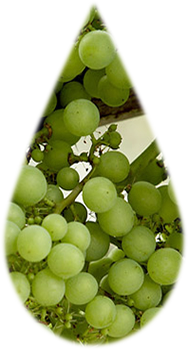 Vitis vinifera
Vitis vinifera
Family: Vitaceae
Part Used: seed
Base oil: can be used 100 percent
The grape is a climbing vine native to Asia. The vine grows to about 30 feet and has green flowers that develop into sweet green or purple-red fruits. Grapeseed oil is produced from the residue of grapes that were pressed for wine. The oil is widely used in creams, massage oils, and on people who are allergic to other oils.
Contains: vitamins, minerals, proteins
Practical uses: general skin care. The carrier/base oil is used to dilute essential oils in aromatherapy for massage oils and other formulations. Grapeseed is a light oil and has a smooth texture.
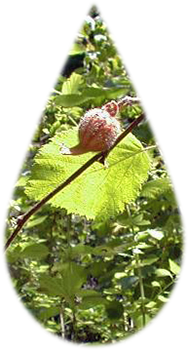 Corylus avellana
Corylus avellana
Family: Betulaceae
Part used: nut
Base oil: can be used 100 percent
Hazelnut is a deciduous tree native to Europe and Asia. The tree grows to a height of about 12 – 30 feet, has green leaves, light-yellow catkins, and red female flowers that develop into nuts. Hazelnut is also known as filbert nut and cob nut.
Contains: vitamins, minerals, protein
Practical uses: has a slight astringent action; good for all skin types. Moisturizes, softens, repairs dry and damaged skin. The carrier/base oil is used to dilute essential oils in aromatherapy for massage oils and other formulations.
 Simmondsia chinensis
Simmondsia chinensis
Family: Buxaceae
Part used: beans
Base oil: use a 10 percent dilution
Jojoba is an evergreen shrub native to the southwestern United States and northern Mexico. The plant grows to a height of about 3 – 18 feet and has small leathery leaves. There are male and female plants. The male flowers are yellow; the female flowers are green and develop into olive-shaped, dark-brown, nutlike fruits containing seeds. The seeds are called goat nuts. Jojoba plants can live up to 200 years.
Contains: protein, minerals, a waxy substance that mimics collagen
Practical uses: inflamed skins, psoriasis, eczema, acne, hair care; good for all skin types, highly penetrative. In skin care, jojoba oil moisturizes and softens dry skin and helps with stretch marks. It can be used in sun tanning for those who burn easily in the sun.
 Olea europaea
Olea europaea
Family: Oleaceae
Part used: fruit
Base oil: use a 10 percent dilution
Olive is an evergreen tree native to the Mediterranean region. The tree reaches a height of about 25 – 40 feet, has smooth grey bark, leathery greenish-grey leaves, and fragrant clusters of white flowers. Olive trees are slow to mature, requiring ten years to start to bear fruit, and thirty years for a sizable crop to be produced. The trees may reach an age of 1,500 years.
Contains: protein, minerals, vitamins
Practical uses: rheumatic conditions, hair care, cosmetics, soothing. The carrier/base oil is used to dilute essential oils in aromatherapy for massage oils and other formulations. For massage oils, it is best to mix 10 – 20 percent of olive oil with other carrier oil before adding the essential oils, due to its thickness.
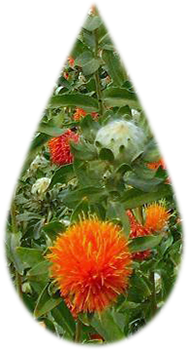 Carthamus tinctorius
Carthamus tinctorius
Family: Asteraceae
Part used: seed
Base oil: can be used 100 percent
Safflower is native to India. The plant grows about 3 feet high and has orange-yellow flowers. The flower heads yield a red and yellow dye, the seeds produce an oil, and the leaves are eaten as a vegetable. Approximately 75 percent of the oil consists of linoleic acid, which is an essential fatty acid that plays an important nutritional role in the body. It has been noted for its ability to slow down digestion and allow the food to combine with the digestive enzymes for proper assimilation.
Practical uses: good for all skin types. The carrier/base oil is used to dilute essential oils in aromatherapy for massage oils and other formulations.
 Helianthus annus
Helianthus annus
Family: Asteraceae
Part used: seeds
Base oil: can be used 100 percent
Sunflower is native to America. The plant grows to a height of about 6 – 15 feet, has a tall hairy stem and red to purple rays with large orange-yellow flower petals that look similar to a large daisy. The flower disc produces edible seeds.
Contains: vitamins, minerals
Practical uses: good for all skin types. The carrier/base oil is used to dilute essential oils in aromatherapy for massage oils and other formulations.
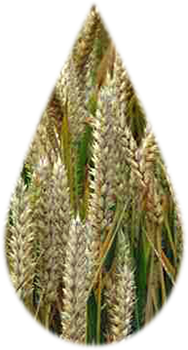 Triticum vulgare
Triticum vulgare
Family: Poaceae
Part used: grains
Base oil: use a 10 percent dilution
The wheat plant belongs to the grass family and grows to a height of about 2 – 4 feet.
Contains: protein, minerals, vitamins
Practical uses: eczema, psoriasis, prematurely aged skin; good for all skin types. The carrier/base oil is used to dilute essential oils in aromatherapy for massage oils and other formulations. For massage oils, it is best to mix 10 percent of wheat germ oil with another carrier before adding the essential oils.

